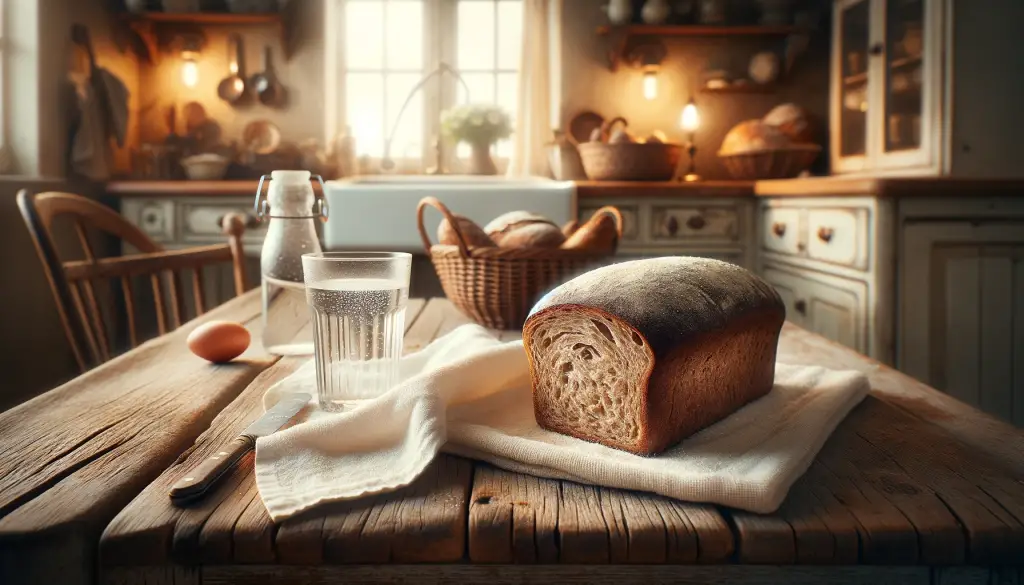In this article, I am going to explain how to rehydrate stale bread so that it regains its original softness and taste, making it enjoyable to eat.
Rehydrating stale bread is a practical way to revive its texture and taste, making it palatable once again. Typically, you can moisten the bread with a little water and heat it to bring back its softness and warmth. This method works well for most types of bread, from baguettes to sandwich loaves.
For a faster solution, if you are pressed for time, you can use a microwave with a damp paper towel to reintroduce moisture quickly and evenly throughout the bread.

Steps to Rehydrate Stale Bread
Assessing the Bread’s Condition
Examine the stale bread. If it has signs of mold or an off odor, it’s best to discard it.
For bread that’s merely dried out, look for any particularly hard sections that might need extra attention during the rehydrating process.
Adding Moisture
Preheat your oven to a low temperature, around 300°F (150°C).
Lightly dampen the surface of the bread with water. Be sparing; the goal is to moisten the bread without making it soggy.
For an even distribution of moisture, use a spray bottle or brush the water on with a pastry brush.
Heating for Softness
Wrap the moistened bread in aluminum foil. This will trap the steam as the bread heats, allowing the moisture to penetrate evenly.
Place the wrapped bread in the preheated oven for about 10 to 15 minutes.
Check the bread; if it’s not yet as soft as you’d like, heat it for a few additional minutes.
Alternative Microwave Method
For a quick rehydration method, wrap the bread in a damp paper towel and microwave it on high for 10-second intervals.
Check the softness after each interval, and continue until the bread reaches the desired level of moisture and warmth.
Serving or Storing
Once the bread is sufficiently rehydrated, it should be served immediately to enjoy its restored texture.
If you must store it, keep the bread in a breadbox or wrapped in a cloth to maintain its softness for a short while longer.
Related Questions:
What is the best time to soften stale bread?
The best time to rehydrate stale bread is just before you’re ready to eat it. Bread rehydrated too far in advance can become tough or stale again.
What are the benefits of rehydrating stale bread?
Rehydrating stale bread can save food that might otherwise be wasted, restoring its texture and making it suitable for eating. It can also enhance the flavor, especially if you add herbs or garlic to the water before moistening the bread.
Can I soften stale bread using liquids other than water?
Yes, you can use milk, broth, or even a beaten egg for rehydration. These can add flavor and richness to the bread, making it suitable for various dishes like French toast or stuffing.
Can you freeze rehydrated stale bread?
It’s not recommended to freeze rehydrated bread as it can affect the texture when thawed. If you need to store rehydrated bread, it’s best to do so at room temperature and consume it within a day.
How can you quickly rehydrate stale bread?
The quickest way to rehydrate stale bread is by using a microwave. Wrap the bread in a damp paper towel and microwave it on high for 10-second intervals until the desired softness is achieved.
Why won’t my stale bread soften?
If your stale bread isn’t softening, the heat may be too low, or it hasn’t been exposed to moisture long enough. Try increasing the oven temperature slightly or moistening the bread a bit more.
Can you rehydrate bread that’s too stale or hard?
Bread that is excessively stale or hard might not rehydrate well and can remain dense or tough. If the bread is too far gone, consider repurposing it into croutons or breadcrumbs instead.
Can you rehydrate stale bread and then store it?
Rehydrated stale bread is best consumed immediately. Storing it after rehydration can lead to a decline in texture, making it tough or stale once more.


